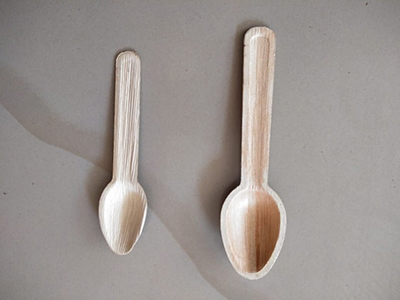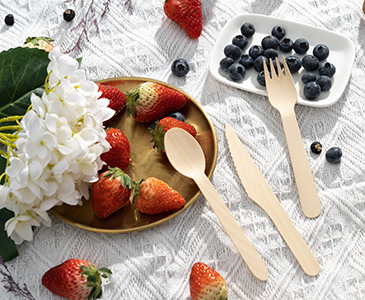Catégories
Nouveau Blog
The 6 Best Eco-Friendly Disposable Cutlery (2023)
April 21 , 2023Eco-friendly products are becoming a trend in all parts of the world due to the growing need for practices to improve the sustainability of the environment and preserve natural resources. When we are talking about eco-friendly products, the food industry can’t be ignored where takeaway containers and other cutlery are a big hindrance to sustainable growth.
An increased trend of customers attracted toward eco-friendly disposable cutlery has been introduced within the industry. Using disposable cutlery is not important for the customers but also has economic significance.
Today, we are going to talk about the eco-friendly disposable cutlery options your business can employ in 2023. We will also discuss the implications, benefits, and disposal of eco-friendly options like sugarcane cutlery, wood, bamboo, etc.
In this article, you will know:

Eco-friendly disposable cutlery can be defined as one manufactured to biodegrade into the environment without leaving harmful residues for the inhabitants of the environment.
The formal definition of disposable cutlery includes tableware utensils made from disposable plastics or paper that are easy to dispose of after initial use. Eco-friendly disposable cutlery disposes of after use, and it doesn’t leave any harmful environmental impacts after decomposition or disposal.
Similarly, there is a difference between eco-friendly and traditional disposable cutlery. The traditional disposable cutlery might be made of plastics that are disposed of or recycled after the initial use, but the process is not environmentally safe. Or otherwise, the production or consumption of such traditional disposable cutlery might release harmful chemicals.
On the other hand, biodegradable or eco-friendly disposable cutlery doesn’t employ any material or process in the whole manufacturing cycle to consumption and disposal that leave an adverse environmental impact. The most commonly used biodegradable materials for eco-friendly cutlery include paper, bamboo, bagasse cutlery, etc.

source: Pexels
The world has used plastics in almost every field of life, including cutlery. However, the pros and limitations of any method come to light after advanced research and development.
Similarly, certain challenges and problems are faced when using disposable plastic cutlery. The most important areas to watch when using disposable plastic cutlery are as follows:

source: Pexels
The increase in carbon footprints, landfill, land pollution, and water pollution can understand the environmental impact of using plastics in disposable cutlery. The carbon footprints of any activity are the total amount of carbon gases emitted during the whole process of material procurement to processing, manufacturing, consuming, and disposing of.
The production process of disposable plastic has high carbon emissions that are deteriorating the environment. Similarly, we cannot ignore the fact that plastic cutlery will end up in landfills, leading to land pollution. Additionally, plastic cutlery releases toxins into the environment, increasing air pollution.
In the case of disposable plastic cutlery, it results in environmental degradation through the release of chemicals like vinyl chloride and benzene. These chemicals can be disastrous for life and ecosystems due to their carcinogenic and neurotoxic properties.
Besides the land ecosystems, the presence of disposable plastic cutlery also poses to be a threat to marine life. The suffocation caused by the presence of plastic in water bodies has resulted in the extinction of several marine species.
After knowing the adversities of regular and disposable plastics, discussing the best eco-friendly disposable cutlery options for commercial use is important. So here are the top six eco-friendly disposable cutlery options to consider in 2023:

source: Google Image
Bagasse is a major byproduct of the sugarcane industry that is left behind after sugarcane juice extraction. The residual bagasse fiber is sturdier and more durable than the regular plastic used in cutlery. You can expect to find all utensils range when it comes to sugarcane bagasse cutlery.
Another excellent feature of bagasse is its fast natural compostability within 60 to 90 days. It is further reduced when done in commercial setups and under controlled conditions.

Bamboo cutlery can also be called one of the best disposable cutlery options after bagasse cutlery. The smooth finish of bamboo cutlery results from the hand-finishing done with natural and food-safe wood oil.
The bamboo cutlery can be either disposable or non-disposable. Regular bamboo cutlery can also be used at restaurants as it won’t go anywhere for 5 to 10 years. If we talk about the compostability of bamboo, it will naturally decompose in around three years. However, the time is reduced to 1-2 weeks in industrial settings and four weeks in residential setups.

source: Pinterest
The disposable plates made of fallen Areca leaves are stylish, sturdy, and microwave safe, like other eco-friendly disposable cutlery options in the market. The palm leaf cutlery are also sturdy and durable.
If we talk about compostability, natural compostability can take as long as 50 years. However, the industrial processes make the natural decomposition possible in around 6 to 8 weeks.

Wood is also an eco-friendly raw material for cutlery manufacturing. The wood cutlery can also be disposable and non-disposable. If we talk about disposable wood cutlery, the trend is not much common, but the non-disposable version is quite popular in restaurants as well as homes.
Wood is 100% biodegradable and compostable, but it can take hundreds of years in natural decomposition. However, industrial processes can improve the process and compost the material in almost 90 days.

source: Google Image
Paper is also a very popular choice for disposable cutlery in commercial settings and events. Whether it is a takeaway food service or a birthday party, the abundance of paper and cardboard cutlery is undeniable.
The durability of paper cutlery can vary depending on the layers used in cardboard or paper. However, the natural decomposition of paper completes in 2 to 6 weeks. However, the most common process on paper is recycling as it is sturdy to resist six recycles before becoming too weak to use.

CPLA, crystallized polylactide, is derived from renewable biomass of fermented plant starch. It is a thermoplastic monomer that is extensively used in decomposable and eco-friendly cutlery.
Compared to traditional plastics, the highest-grade starch-based raw material makes it heat-resistant and compostable. The decomposing time of CPLA can range from up to 50 years in natural settings. However, the commercial facilities can decompose it in 2 to 4 months.

source: Pinterest
The benefits of using eco-friendly disposable cutlery are two-fold: for the environment and for business. These eco-friendly alternatives to plastic offer the following benefits:
1. Lower carbon emissions during the manufacturing, consumption, and decomposition cycles
2. Reduce landfill and water pollutants when organic and eco-friendly options replace plastics
3. Businesses can achieve cost optimization goals by saving on processes and supply chain management.
4. Businesses can capitalize the customer preference to buy eco-friendly products and packaging.
5. Increases the social and corporate responsibility ratings of a brand and also improves the brand image
However, brands and restaurants should make sure to choose cutlery having the necessary certification like:
· BPI Certification for Compostable Cutlery
· ISO/HACCP/NSF Certifications
· Intertek Testing Report for Eco-Friendly CPLA Cutlery
· And other relevant certifications.

source: Pinterest
Here is the proper way to dispose of any of the eco-friendly disposable cutlery:
1. The best option to dispose of eco-friendly disposable cutlery is composting or Trashing. You should try to compose biodegradable disposable cutlery in your backyard or curbside. If your area has any community compost program, it can also be utilized to compost the materials.
2. It is important to watch that you’re composting the items having a compostable label, and such cutlery should be composted in industrial facilities only.
3. Always check the list of acceptable items before disposing of any cutlery at the composting facility.
4. If the cutlery has the label of compostable, it will be composted and otherwise sent to trash.
We have discussed eco-friendly disposable cutlery, including the best six options to employ eco-friendly options in your food or restaurant business. The use of eco-friendly options like bagasse, wood, bamboo, paper, etc., should be encouraged as it eliminates the negative impact of traditional plastics on the environment.
The use of biodegradable and disposable cutlery reduces the material’s environmental impacts and serves economic benefits for business entities. You should check the label of the packaging before disposing of certain materials in a properly declared way.
As a socially responsible business entity, we are responsible for encouraging the use of eco-friendly alternatives that helps us achieve sustainable growth and the environment. Therefore, it is right for your restaurant or food business to switch to disposable and eco-friendly cutlery items to replace traditional ones.